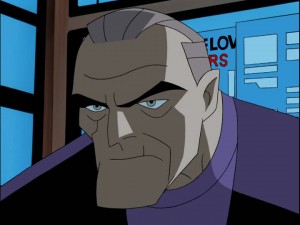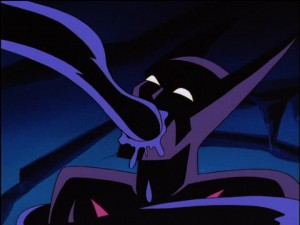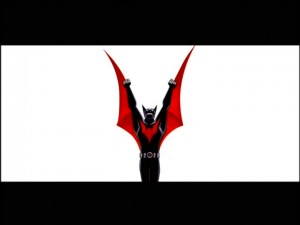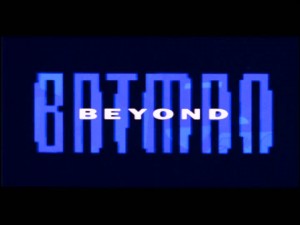
BUY IT FROM AMAZON: Click Here
STUDIO: Warner Brothers
MSRP: 99.98
RATING: NR
RUNNING TIME: 1097 Minutes
SPECIAL FEATURES:
- Commentaries on select episodes
- Inside Batman Beyond roundtable discussions
- Close Up On…(Season 3)
- Tomorrow Knight: The Batman Reborn
- Gotham: City of the Future
- Secret Origins: The Story of DC Comics
The Pitch
Batman. But TO THE XTREEEEEEEEMEOMGWTFBBQASPCATITSORGTFOMST3K!!!!1!1!!
The Humans
Will Friedle, Kevin Conroy, everyone awesome in this world.
The Nutshell
50 years after a retired Bruce Wayne gives up the mantle of the Dark Knight, a young man named Terry McGinnis, another child of tragedy, stumbles onto the former hero’s secret, and is hesitantly taken under his wing to become the new protector of Gotham.
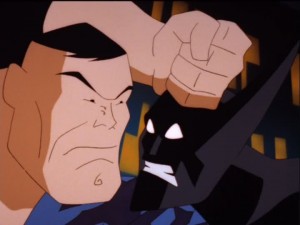
Hank Rollins' Batman interview was already a strange, stunted, awkward affair. And then the mopey prick brought up Johnny Mnemonic.
The Lowdown
Batman Beyond was the last hurrah of a golden age of Saturday morning cartoons far as I’m concerned, and for that, I apologize in advance for stealing some of the thunder of the good folks handling the Saturday Morning column for the site. This would be a perfect capper for whenever that column finally ran out of material. Anyway, judging from the crap I saw when I last flipped through channels on a Saturday morning, I can’t wrap my head around this being an environment where Animaniacs, Freakazoid, the 90s X-Men, or Batman The Animated Series could thrive. I still remember that one awesome year, long before animation, well, dominated Fox on Sundays, where B:TAS was shifted to prime time before In Living Color, which had NEVER been done, and yet the show seemed perfectly at home, before the Futurama effect took hold and football, like the asshole it is, would constantly screw the show out of its adult audience. Either way, for a good solid 9 years, it wasn’t out of the question to see grown men and women talking about what happened on X-Men last week.
Batman Beyond was a perfect transitional show in that respect. The need for cartoons to start aiming for their bread and butter–that is, the kids of parents with massive toy/cereal budgets–is apparent, as one watches the evolution of animated Batman through the 90s from the beautiful, black paper aesthetic of the original series to a simpler, geometric, streamlined one, borrowed from Superman: The Animated Series, a shorthand aesthetic that Beyond carries over. And in theory, the downfall was already complete, once some Kids WB sycophant called Paul Dini and told him they wanted to make Batman hip, cool, and edgy.
With all that in mind, it’s kind of a minor miracle that Batman Beyond is as good as it is. Bruce Timm and Co. took a huge risk inventing some punk kid to take on the cowl, but instead of forcing that fact on their fanbase, it instead becomes the underlying basis of the whole show; the fact that Terry McGinnis is a complete novice. He has a solid foundation rooted in gymnastics, and an instinctive handle on the technology of the new, truly badass Batsuit, but becoming Batman involves so much more. The problems in trying to mold this kid into someone who can shoulder everything that comes with the mantle are what carry this show, not the villains.
As such, the show is easier to appreciate as a 3 season arc, rather than individual stories. As individual stories, Beyond often settles for merely entertaining, but it’s the tiny moments stand out. The moments that keep fans engaged past the frenetic, often extremely well executed action are the ones that put the now-genuinely crotchety Bruce Wayne and Terry McGinnis in conflicts of methodology, from Terry’s willingness to forgive Victor Fries, an instinct that turns out to be right, to Bruce reaming him for beating the hell out of a suspected villain, only to find out he’s innocent.
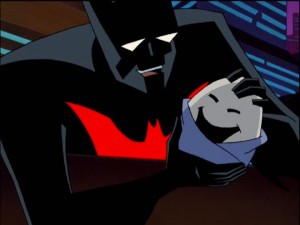
In retrospect, the 78% slide in egg sales in Japan probably had something to do with their new spokeperson. A lot, in fact.
The show is full of stopgaps of great character choices that make the often maudlin, easy plots in the first season and a half or so much easier to forgive. The series overrelies on past heroes and villains for too much of the first season, but stuff like the ultimate, fucked up fate of Bane, Barbara Gordon taking up her father’s post, and her interracial relationship are rather special touches that enrich the mythology instead of throwing blind caution to it. Later in the series, Terry’s given what could’ve been creative death in the form of a “sassy” black sidekick named Max. Thankfully, the showrunners are way too smart to fall into any of the pitfalls here, and Max is actually smartly written. She’s a perfect balance with Terry, his voice of non-senior citizen reason, occasionally falling into peril, but never without a fight. In the special features, there’s a discussion about an unproduced episode that would’ve actually made Max Terry’s love interest, and given how the show does nothing with Terry’s long-jilted girlfriend Dana, it’s a shame they never took the risk. She’s a stronger character who knows he’s Batman, and more than capable of keeping up with him. Instead, she acts more as his Alfred.
The problem with all that is it takes a rather long stretch of time for the show to establish its own identity as a result. The character of Inque is a good starting point, as she’s one of the stronger members of the new rogue’s gallery, coupled with some of the most spectacularly creepy animation the show has to offer. A few of the new villains offer grand action opportunities–the highlight of the whole show is a fight with sound-altering villain Shriek, conducted in total silence, the climax of which leaves Shriek deaf for the rest of the series–but nothing that lasts. There’s no game-raising tragedies the likes of the Two-Face two-parter, or Poison Ivy cloning a traditional family out of plant matter just to be left alone, or the imagined but still harrowing tale of how the crimefighters of Gotham react to Batgirl’s death. Blight, the man who killed Terry McGinnis’ father, is as close as the series gets, but he’s dispatched in Season 1, and leaves a hole the series never fills. It’s like if Superman killed Lex Luthor in the first issue.
The series does still soldier on through its downfalls, however, and it does hit numerous highs. Later in the series, Terry’s exploits end up being based around villains targeting his high school classmates, or kids even younger, and there’s a particular focus on the effects missing or wayward children have on their often dysfunctional families that actually does end up hitting its mark every time. There are more and more glimpses as time goes on of Terry McGinnis coming into his own as the new Dark Knight, a particularly glorious moment occurring after a minor argument with Max, where a fully suited McGinnis tells her “Don’t call me Terry.” The “edgy” aspects of the show at first seem like a crutch for cool, with wailing guitars and the typical Blade Runner/Akira-esque landscape of Gotham, but the show eventually embraces its dark side, leading to some genuinely disturbing tales being told. Inque goes from being just a well-designed animation wank to being a chilling case of body horror in her last show appearance. An episode involving the origin of Bruce’s helper dog, Ace, pulls surprisingly few punches in showing off the underground dogfighting ring from which he came. And on a very simple level, the list of guest stars they managed to corral for this show would be impressive by prime time standards. Every time someone like William H. Macy, John Ritter, Patton Oswalt, or Henry Rollins (who, pun unintended, is just having a total blast here playing, ostensibly, a pyromaniac version of himself) shows up just lends a weight to the proceedings the stories absolutely need. You wonder at first why a C-grade group of villains like The Royal Flush Gang works so well, and then you realize George Lazenby’s playing the King.
Unfortunately, the series closes out on these discs with a whimper, as the production team had no idea if they would get a fourth season or not, leaving the series as it stands on these discs unresolved with a decent, but narratively unsatisfying tale of a little boy who sees Batman without his mask. The elephants in the room, which ultimately the set suffers for not including, are the Return of the Joker direct-to-video movie, and the Justice League Unlimited series finale, “Epilogue”, an episode which wraps up the Bruce Timm/Paul Dini run on DC Animation altogether. Together, they are not just the perfect, elegiac send-off to the mature era of animated Dark Knight adventures, but they also see the full becoming of the new Batman. With the series behind him as a foundation, Terry McGinnis continuing the legacy doesn’t just seem logical, but right. Batman Beyond is less a series of adventures, nor is it just an attempt to make Batman cool as a result. It’s three seasons of a torch being slowly, gracefully earned and passed to a younger generation, and it’s quite respectful of that journey.
Ironically, that actually *does* make it the last time Saturday morning would be cool, hip, or edgy.
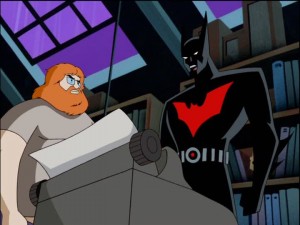
Batman had been more than happy to let Harry Knowles write the forward to the 75th Anniversary release of Dark Knight Returns. Until he found the paragraph comparing the comic to getting a rimjob from Frank Miller. Suddenly, the Batman's no-kill code found itself with a loophole.
The Package
At first glance, this is a gorgeous set. There’s a plastic slipcover over a solid cardboard box about the size of an old school laptop. However, it’s only that big due to the art book. While really nice, with a great, honest foreword by Bruce Timm, it doesn’t really warrant the pomp and circumstance this massive thing hints at. The actual discs for the series are in a simple hard Amaray case. While the case is perfect, the outer coating is not. That is to say, whatever the material is they used to hold the cover in place is the same shit the Duggars use for condoms. I usually treat my DVDs better than some of the human babies I’ve held, and after a month, there’s tears, scuffs, and rips all along the spine of this thing just from general travel. For a collector’s set, better is and should be expected.
Anywho, the discs themselves are just the previous releases of each season, in one handy dandy place. And it shows. The A/V quality on both is par for the course for a kids’ TV show, sadly, and this is the kind of show that begs for a 5.1 mix. The commentaries are casual, but informative affairs. The roundtable discussions that cap each season are too short for my tastes, but more gets crammed into them that you’d expect. Unfortunately, they figured out they could have done more too late, as Season 3 gets the best of the old school disc features, a Close Up on 5 of the episodes of the season, with Will Friedle sitting in as well. These are far more in depth and critical of what works and what doesn’t in each, particularly with “Curse of Kobra”, which really is a missed opportunity considering the perfect setup in part 1.
The new disc is simple, but informative enough. The two brand new docs are short–about 10 minutes a pop–but everyone gets to chime in with their two cents about the inception of a teenaged Batman, and a futuristic Gotham City, and all the pitfalls they tried to avoid or emphasize. The Secret Origins documentary is good, but I swear I’ve seen this pop up on another Warner Brothers/DC Animation disc, and the fact that it’s available on its own is the worst kind of redundancy, especially when they could’ve slapped Return of the Joker or “Epilogue” in here in its stead without even breaking the disc limit. One can easily track down all 3 seasons of this show for under $60. The artbook and the new disc are not $30 by themselves. Spend Wisely.




out of a possible 5 stars
